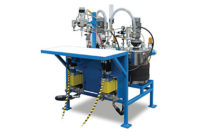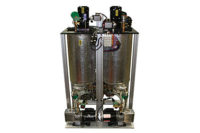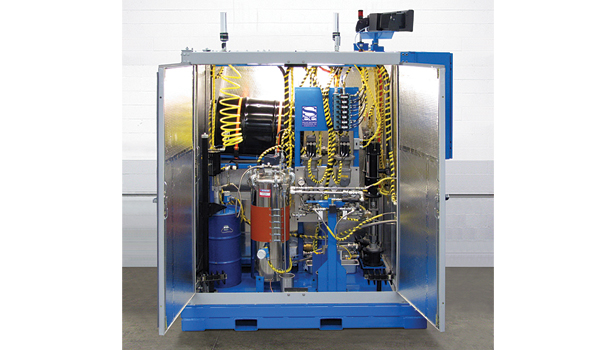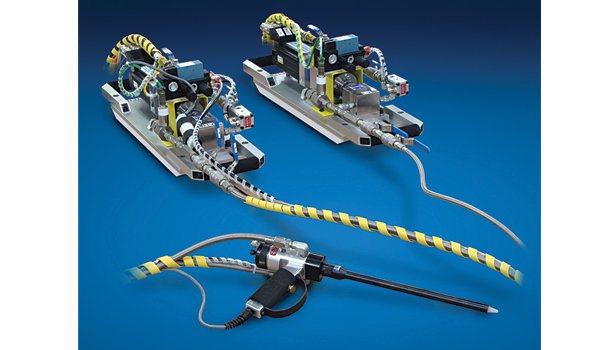Meter/Mix/Dispensing for Polyurethane Elastomers

This enclosed system includes an in-line mixer and is temperature controlled.

Portable gear meters.


Polyurethane dispensing systems continue to evolve for new processes and economic demands.
Two-part polyurethane elastomer materials, such as polyols and isocyanates, continue to grow in formula variations and are expanding their use with product manufacturers due to their improved performance over other materials. One current example of formula growth is the development by many chemical manufacturers of green, eco-friendly, bio-based, sustainable polyurethanes as an alternative to petrochemical-based products. In many cases, these new formulations affect the design of meter/mix/dispensing equipment.
When compared to epoxies, silicones, polyesters and methacrylates, reactive cure polyurethanes for low-pressure dispensing have unique characteristics, such as faster cure, change ratio to adjust durometer, and increased resistance to external issues and influences. Reactive cure polyurethanes are sometimes used to replace one-part, heat-cure polyvinyl chloride (PVC), two-part epoxies, two-part silicones, two-part polyesters and other materials. One example is two-part, fast-cure polyurethane replacing heat-cure PVC in the filter industry for durometer control, increased resistance to chemicals and high-speed manufacturing.
Two-part polyurethane elastomers have characteristics that usually cause meter/mix/dispensing systems to differ from dispensing systems for other materials. The two-part polyurethane equipment usually needs to include different supply units, temperature control, degassing equipment, air dryers and unique mixers. In addition, the use of reactive polyurethane typically requires precision dispensing systems. Tight ratio tolerances and precise dispense volumes are often more important with fast-cure urethane and high-speed automation applications.
Reactive Metering Technology
The two-part metering technology selected for the polyurethane dispensing system is the most critical component of the machine. The metering unit controls the ratio and flow of the polyol and iso materials. Metering technology selection is based on numerous variables, including flow rate, volume dispensed per application, mix ratio by volume and accessory requirements. Selecting the right metering technology determines the performance of the entire dispensing system, the success of the process and the ability of the system to meet all dispensing requirements. If the wrong metering technology is selected, the system would need modifications, accessories or new equipment in order to satisfy the application requirements.
The most common metering equipment types for dispensing reactive polyurethane are defined by two categories of meters: continuous flow meters and shot dispense meters. Each meter has its own need for process control and matching application requirements based on the volume of material required per product manufactured.
Meters can be defined as either fixed or variable ratio, and each type has distinct advantages. Fixed-ratio meters prevent changing or tampering with the ratio and require a mechanical component replacement, such as a complete meter or component, to change the ratio. Variable-ratio meters with one drive motor require a mechanical adjustment to change the ratio. Variable-ratio meters with dual-independent drive motors (each with their own speed controls) use a simple electronic adjustment in the control panel.
The purpose of selecting a variable-ratio meter is to adjust the ratio for variations of the current formula (e.g., adjusting the durometer), when the formulation needs a new ratio, or when changing material suppliers with a new ratio requirement. Variable-ratio meters are excellent systems for material formulators and manufacturers who want a lab unit for analysis of various two-part chemistries.
Types of Meters
Eight meter designs—also referred to as metering principles—are available on the market today. Five of these are commonly used for dispensing reactive polyurethane. The most common types of meter designs for two-part polyurethane elastomers are precision spur gear meters, gerotor gear meters, double acting ball and check meters, reciprocating piston meters, and positive rod displacement meters. Each of these meters has advantages and disadvantages, such as dispensing performance, product life, system price, spare parts, and serviceability.
The first four meters, with gear metering being a popular choice, are ideal for continuous flow or on-demand dispensing applications and can include accessories to dispense a measured volume of polyurethane. The positive rod displacement meter is ideal for dispensing precise volumetric-controlled shots of polyurethane, has the least amount of meter moving parts for long life, and is available as a single- or double-acting meter.
Each of the metering principles can be engineered as fixed- or adjustable-ratio meters. Some meter system manufacturers focus on one or two metering principles, while other manufacturers focus on the full range of engineered meter designs to ensure the selected meter matches the customer’s dispensing requirements for the polyurethane application and manufacturing process.
The Importance of Meter Drive Motors
Each polyurethane meter system is powered by one or two drive motors to cause the A and B materials to be dispensed at the right flow rate and pressure to the mixing unit. One motor can drive both A and B metering assemblies, but with limited system capabilities. Two independent drive motors are used when each meter assembly is designed to dispense independently to maximize the system performance (e.g., adjusting ratio or maintaining ratio at the start of dispense).
In the same way that the metering unit is designed, a drive motor is engineered into the metering system for intended performance, precision and price. Motor drives used in polyurethane meters vary from high precision to basic units, such as servo motor, stepper motor, VFD motor, servo-hydraulic, hydraulic, air-over-oil and pneumatic. Motor drive selection is as important as the urethane meter design selection to ensure all meter system variables (e.g., ratio, flow rate, volume, etc.) are properly used and controlled for the success of the application.
Dispensing Process Configurations
Polyurethane dispensing system manufacturers may develop “out-of-the-box” standard systems to meet the demand of focused market segments or custom-only systems to meet the specification of a variety of end users. Some unique manufacturers provide both standard and custom systems by modifying standard systems as needed by the customer or to adapt to new product requirements and polyurethane market trends.
Common metering configurations include frame- and floor-mounted, baseplate- or stand-mounted, cabinet-mounted, mobile caster or cart-mounted (system includes controls and supply), unitized frame-mounted, workbench, manually portable, totally enclosed and temperature-controlled, and automation configured polyurethane meter/mix/dispensing systems.
Product manufacturers continue to increase their use of automated polyurethane dispensing processes to improve product quality, increase production rate, reduce product rework and scrap, and other factors that lower the total cost. Automating the meter/mix/dispensing process requires higher initial capital investment, including the polyurethane dispensing system and automation process, yet can have an excellent ROI that lasts for many years. Popular choices for the manufacturer’s automated dispensing cell include a XYZ gantry style robot or a 6-axis articulating robot which, in concert with the metering system, places the mixed polyurethane into or onto the part with repeatable precision and speed.
Mix/Dispense Solutions
Unlike other chemistries, two-part polyurethanes elastomers have a wide range of mixing requirements due to their A and B chemistry and compatibility. Formulations that are easier to mix can use a basic mixer, but more difficult materials need a high-performance mixer. Polyurethane mixers may include on-off valves to start and stop the flow of A and B materials, controls to adjust flow and pressure, devices to monitor flow and pressure, and methods for low-pressure foaming, cleaning or flushing the mixer such as nucleating, resin injection, air, or solvent.
Mixing solutions are selected based on the polyurethane formulation and the ability to mix A and B into a homogenous mixture before dispensing the mixture into/onto the part or mold. Mixer designs for low-pressure polyurethane mixing, starting with the basic, include: single-valve static mixer, dual-valve static mixer, rotary powered static mixer (pneumatic or servo drive), in-line static mixer, and impeller dynamic mixer. These mixers are either static (non-powered) or powered by pneumatic motors, hydraulic motors or servo drive motors, and are selected by their mixing performance based on viscosity, ratio, flow rate, fluid pressure, ability to mix, and price.
Supply Units and Accessories
Polyurethane components A and B are packaged by formulators in a variety of containers from tanker cars to cartridges, including drums and pails. The container size is selected by the polyurethane supplier and purchaser based on full use before the expiration date and price. Polyurethanes can be supplied to the metering system from their original shipping containers or transferred into the metering system supply units for re-delivery to the meter. Level seeking A and B materials can be supplied by gravity-feed vessels, pressure tanks and booster pumps (diaphragm or two-ball reciprocating). Viscous or paste materials shipped in pails or drums use double-acting ram pumps for supplying materials to the polyurethane meter.
Supply units, as well as the meter and mixer, sometimes require additional accessories to stabilize or perfect the A and B materials in the polyurethane meter/mix/dispensing system. The supply units may need fluid level control, vacuum de-gassing or automatic crossover controls for continuous operation. The metering unit may need circulation of the materials from the mixer to the supply units to stabilize the system. The entire system may need temperature control of the materials for stabilization and proper curing. Temperature control for the urethane system can be in the form of electric heat, water heat and cool, or piezoelectric heat and cool.
System controls can create excellent performance or limit the use of a meter/mix/dispensing system. If only one product is being manufactured, the system control can be simple. If one dispensing system is needed to dispense polyurethane for many different parts, create variations in flow or volume, control other accessories, or be used for future products, the controls choices have more advanced features. In some dispensing systems, such as dual servo-drive metering units, the controls are advanced enough to handle virtually any ratio and dispensing process needed.
Finding a Solution
It is important to have a polyurethane meter/mix/dispensing system that is trouble-free and designed to meet specific application requirements. For two-part polyurethane dispensing, you do not want to leverage a lesser performing system into a process with higher expectations. Select and recommend your polyurethane system manufacturer based on their ability to meet your current and future dispensing requirements. The system should offer a ROI that includes the expected total life cost of the system.
References for this article were provided by Ken Jacobs, V.P.-Global Sales and Marketing, Sealant Equipment & Engineering, Inc. For more information, contact Sealant Equipment & Engineering, Inc. at 45677 Helm, Plymouth, MI 48170; phone (734) 459-8600; email sales@sealantequipment.com; or visit www.sealantequipment.com.
Looking for a reprint of this article?
From high-res PDFs to custom plaques, order your copy today!










